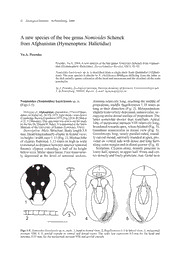
A new species of the bee genus Nomioides Schenck from Afghanistan (Hymenoptera: Halictidae) PDF
Preview A new species of the bee genus Nomioides Schenck from Afghanistan (Hymenoptera: Halictidae)
© Zoological Institute, St.Petersburg, 2004 A new species of the bee genus Nomioides Schenck from Afghanistan (Hymenoptera: Halictidae) Yu.A. Pesenko Pesenko, Yu.A. 2004. A new species of the bee genus Nomioides Schenck from Afghani- stan (Hymenoptera: Halictidae). Zoosystematica Rossica, 13(1): 81-82. Nomioides bactriensis sp. n. is described from a single male from Quandahar (Afghani- stan). The new species is similar to N. chalybeatus Blüthgen differing from the latter in the dull metallic green coloration of the head and mesosoma and the structure of the male terminalia. Yu.A. Pesenko, Zoological Institute, Russian Academy of Sciences, Universitetskaya nab. 1, St.Petersburg 199034, Russia. E-mail: [email protected] Nomioides (Nomioides) bactriensis sp. n. Antenna relatively long, reaching the middle of (Figs 1-5) propodeum; middle flagellomeres 1.35 times as long as their diameters (Fig. 2). Metapostnotum Holotype: M, Afghanistan, Quandahar, 37 km of Quan- slightly transversely depressed, semicircular, oc- dahar, on Kabul rd., 24.VII.1975, light shrub / semi-desert cupying entire dorsal surface of propodeum. The (Cambridge Bactria Expedition 1975, [leg.] [P.H. B.] Baker latter somewhat shorter than scutellum. Apical et [E. J.] Munday). This specimen was sent to me for study lobe of metasomal sternum VIII relatively long, by the late Dr. Donald B. Baker. It is deposited at the Snow Museum of the University of Kansas (Lawrence, USA). broadened towards apex, where bilobed (Fig. 3). Description. Male. Structure. Body length 3.8 Gonobase semicircular in dorsal view (Fig. 5). mm. Head longitudinally elliptic in frontal view; Gonoforceps long, nearly parallel-sided, round- its height / width ratio 1.15 (Fig. 1). Median lobe ly curved mesad, narrowly rounded at apex, pro- of clypeus flattened, 1.13 times as high as wide vided on ventral side with dense and long hairs (estimated as distance between anterior tentorial along outer margin and in distal quarter (Fig. 4). fossae); clypeus extending a half of its height Sculpture. Clypeus shiny, densely punctate in below eyes. Malar space linear. Face transverse- lower half, sparser, in upper half. Frons and ver- ly depressed at the level of antennal sockets. tex densely and finely granulate, mat. Genal area 1 3 2 4 5 Figs 1-5. Nomioides bactriensis sp. n., male. 1, head in frontal view; 2, flagellomeres 1-5 in lateral view; 3, metasomal sternum VIII; 4, 5, genital capsule in ventral and dorsal views. The scale line represents 0.5 mm for the head and antenna; 0.25 mm, for the metasomal sternum VIII and genital capsule. 82 Yu.A. Pesenko: A new Nomioides from Afghanistan (cid:127) ZOOSYST. ROSSICA Vol. 13 weakly shiny, densely obscurely punctate. Meso- whitish yellow. Flagellum ochre-yellow on low- scutum shiny, with traces of very obscure granu- er side, fuscous on upper side. Wing membrane lation in anterior third and with few obscure punc- hyaline; veins light yellow. tures. Scutellum polished, with few punctures. Vestiture. Relatively poor, whitish. White to- Mes- and metepisterna finely granulate, mat. mentum present only on dark-coloured parts of Metapostnotum silky mat, finely and densely face below antennal sockets and as tracts on ge- granulate, with short fine striae in anterior third. nal areas. Metasomal tergum I mat, densely and finely granu- Female unknown. late; tergum II submat; subsequent terga shinier. Comparison. In the size, structure, poor pale Coloration. Main coloration of head and mes- pattern of the body, and the high head, the new osoma metallic dull olive-green; of metasoma, species is similar to N. chalybeatus Blüthgen black, without metallic tints. Labrum, clypeus, occurring in Kazakhstan, Turkmenistan, Uz- spot on supraclypeal area (Fig. 1), mandibles (ex- bekistan, and Tajikistan, but differs from the lat- cept for reddish apices), malar spaces, scapus on ter in the metallic dull-green coloration of the lower side, pronotal collar and spiracular lobes, head and mesosoma and in the structure of the scutellar crests, median area of metanotum, spot male terminalia (bilobed metasomal sternum VIII on infuscate tegula, basal sclerites of wings, fore and unusually dense and long pubescence of the and middle legs, hind tibia and tarsus, pregradu- gonoforceps). lar areas of metasomal terga II-V seen through translucent posterior areas of preceding terga; all Received 2 June 2004
